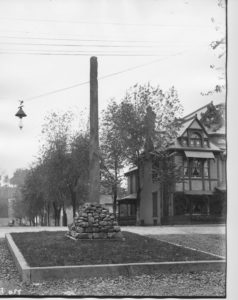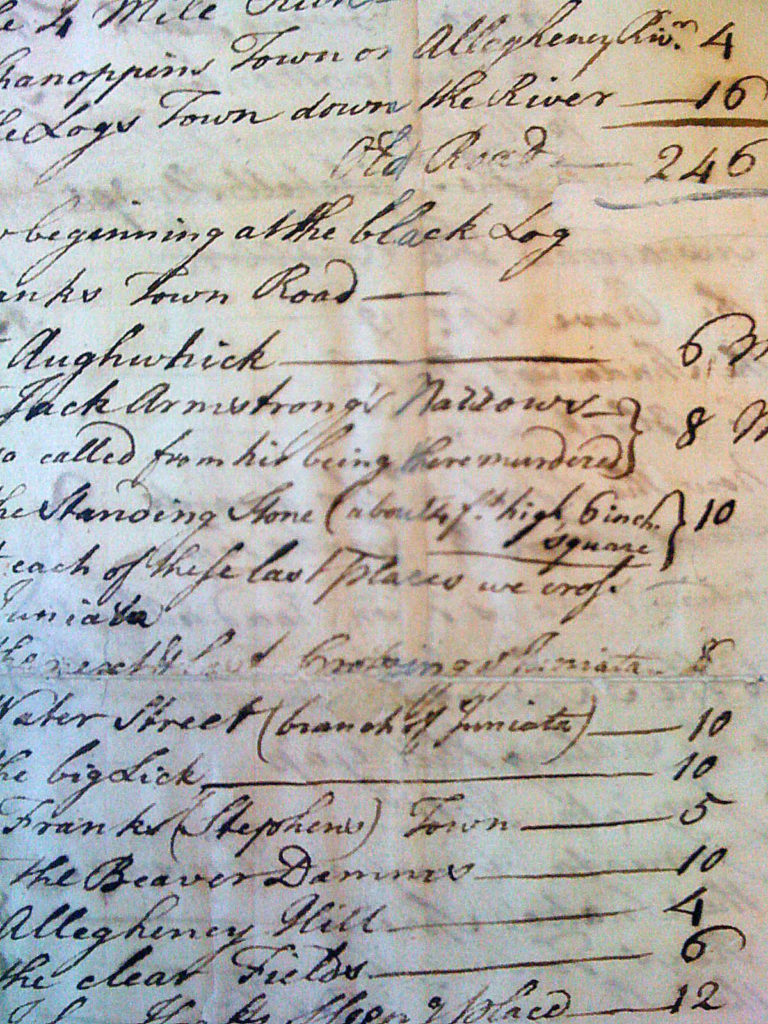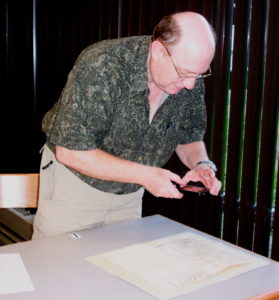Certainly no object associated with the history of Huntingdon Borough is more iconic than the Standing Stone. The tall, slim monolith that stands on William Smith Street today prompts residents and visitors alike to ask questions about its history and significance.
 The present monument is the third Standing Stone in recorded history, erected for the borough’s Centennial celebration in 1896 as a memorial to the Native American stone that gave Huntingdon its earliest name. Indian trader and interpreter Conrad Weiser is credited with being the first to record a reference to the Standing Stone in a journal of his travels through the area in 1748.
The present monument is the third Standing Stone in recorded history, erected for the borough’s Centennial celebration in 1896 as a memorial to the Native American stone that gave Huntingdon its earliest name. Indian trader and interpreter Conrad Weiser is credited with being the first to record a reference to the Standing Stone in a journal of his travels through the area in 1748.
Six years later, in 1754, John Harris also recorded the Standing Stone in his “Account of the Road to Logs Town on Allegeheney River,” giving its dimensions as 14 feet tall and 6 inches square. What Weiser and Harris saw was the Indian stone, said to be venerated by those who erected it and who apparently removed, destroyed, or concealed it in response to the first signs of white settlement in the area.
By 1768, early surveyors had raised a stone bearing their names to replace the missing Indian stone. It is this second stone that survives in part and is displayed in the lobby of the Huntingdon County Courthouse. [See “From An Account Written by William R. Smith,” under Historic Documents, for more about this second stone.]
The third, and present, stone was erected during Huntingdon Borough’s Centennial celebration in September 1896. At its dedication, J. Simpson Africa gave an address, in part of which he traced the origin of the words “Juniata” and “Oneida” to an Indian word meaning standing stone.
A couple of months ago, Fred Lang, a board member of the Huntingdon County Historical Society and creative director at Isett Acres Museum, was browsing old files of source material used by local historian Albert Rung for the series of articles he wrote for The Daily News between 1945 and 1972. Tucked away in a file on the Standing Stone was an article written in 1939 for The Sentinel (Lewistown) by Leffard M.A. Haughwout. In it, Haughwout reported that he had examined the Harris document and that it said the original standing stone was 4 feet tall, not 14 feet.

This is the document Haughwout described in the 1939 Sentinel article. Note that the paper mending strip, used in an early preservation effort, obscured the end of the word “about” and the “1” of “14.” When the gap was filled by writing “about” in full on the strip, it appeared that Harris gave the height of the stone as 4 ft.
Puzzled by the discrepancy between Haughwout’s reading of the Harris manuscript and the height of 14 feet given in Africa’s History of Huntingdon and Blair Counties (page 27), Lang decided that further investigation was in order. Africa had reproduced the wording of the Harris document exactly as it appeared in the published Pennsylvania Archives (First series, II, 135-136). In both cases, the word “about,” preceding “14,” is abbreviated: the “u” is omitted, and the “t” is a small superscript letter — abot.

Lang photographing the Harris document.
In July, Lang and Nancy Shedd went to the Pennsylvania State Archives in Harrisburg to have a look at the Harris manuscript. Working with Jonathan Stayer, Supervisor of Reference Services, they examined the original Harris document and found that a break in the paper had been mended by applying a narrow strip of paper to the reverse of the first page, thus obscuring part of the word “about” and the “1” of the number “14.” The missing letters that were obscured by the mending paper had been filled in with pencil; in the line describing the dimensions of the Standing Stone, “about” was now spelled out in full, leaving no space for the “1” of “14.” It was relatively easy to see what had happened, which had resulted in reducing the monumental stone to a mere four feet in height. Clearly, a paper conservator would be required in order for Harris’s observation on the dimensions of the original stone to be uncovered.

The paper strip was removed in recent conservation of the Harris document, thus revealing the small superscript t and the 14 ft. which Harris estimated was the height of the original stone.
Conservation of the Harris manuscript by removing the mending paper, thus revealing once again the estimated height Harris intended, has been accomplished with financial support from J. Melvin Isett. This being the only record of the dimensions of the original Indian stone, its importance as a document in Huntingdon Borough history cannot be overstated.
